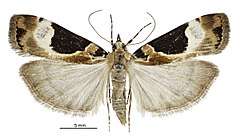Eudonia aspidota
Eudonia aspidota is a moth in the family Crambidae. It is found in New Zealand.
| Eudonia aspidota | |
|---|---|
 | |
| Female | |
 | |
| Male | |
| Scientific classification | |
| Kingdom: | |
| Phylum: | |
| Class: | |
| Order: | |
| Family: | |
| Genus: | |
| Species: | E. aspidota |
| Binomial name | |
| Eudonia aspidota (Meyrick, 1884) | |
| Synonyms | |
| |
Taxonomy
This species was first described by Edward Meyrick in 1884 and named Xeroscopa aspidota.[1][2] Meyrick added further detail when he described the species later in 1884.[3] In 1913 Meyrick placed the species within the genus Scoparia.[4]
Description
The wingspan is 22–26 mm. The forewings are light ochreous, sometimes mixed with reddish-ochreous. There is a black white-margined triangular spot on the costa. The hindwings are pale grey with a darker grey post medial and hind marginal line.[3]
Although the wing markings of this species attract attention, they also imitate bird droppings.[5] This mimicry offers protection to E. aspidota when it is not in flight.
Distribution
E. aspidota is endemic in New Zealand.[6] Meyrick stated it could be found in Wellington, Castle Hill, Mount Hutt, Dunedin and Lake Wakatipu.[3] George Hudson added to the localities where E. aspidota could be found and included Raurimu, Waimarino, Buller River, Invercargill and Stewart Island.[5] Hudson was of the opinion that the species was probably distributed throughout New Zealand.[5]
Ecology and habitat
The habitat of this species is amongst forest.[5]
Host plants
The larvae of this species lives on mosses.[7]
Occurrence
Adults of E. aspidota are normally present during December and January.[3] This species is attracted to light.[5]
References
| Wikimedia Commons has media related to Eudonia aspidota. |
- Meyrick, Edward (1884). "Descriptions of New Zealand Microlepidoptera. IV. Scopariadae". New Zealand Journal of Science. 2: 235–237 – via Biodiversity Heritage Library.
- Gordon, Dennis P., ed. (2010). New Zealand inventory of biodiversity. Volume two. Kingdom animalia : chaetognatha, ecdysozoa, ichnofossils. Vol. 2. Christchurch, N.Z.: Canterbury University Press. p. 458. ISBN 9781877257933. OCLC 973607714.
- Meyrick, E. (1884). "Descriptions of New Zealand Micro-Lepidoptera". Transactions and Proceedings of the New Zealand Institute. 17: 68–149 – via Biodiversity Heritage Library.
- Meyrick, E. (1913). "A revision of New Zealand Pyralidina". Transactions and Proceedings of the New Zealand Institute. 45: 30–51 – via Biodiversity Heritage Library.
- Hudson, G. V. (1928). The Butterflies and Moths of New Zealand. Wellington: Ferguson & Osborn Ltd. pp. 201–202.
- "Eudonia aspidota (Meyrick, 1884)". www.nzor.org.nz. Landcare Research New Zealand Ltd. Retrieved 17 December 2017.
- Patrick, Hamish J.H.; Bowie, Mike H.; Fox, Barry W.; Patrick, Brian H. (2011). "The moths of Quail Island (Ōtamahua): a faunal comparison of an island under restoration with other sites on Banks Peninsula" (PDF). New Zealand Natural Sciences. 36: 57–72.